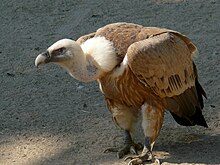Griffon Vulture
| Griffon Vulture | |
|---|---|
 | |
| At Oakland Zoo, USA | |
| Conservation status | |
| Scientific classification | |
| Kingdom: | Animalia |
| Phylum: | Chordata |
| Class: | Aves |
| Order: | Falconiformes |
| Family: | Accipitridae |
| Genus: | Gyps |
| Species: | G. fulvus |
| Binomial name | |
| Gyps fulvus (Hablizl, 1783) | |
 | |
| Dark green: areas of year-round habitation | |
The Griffon Vulture (Gyps fulvus) is a large Old World vulture in the bird of prey family Accipitridae.
The Griffon Vulture is 93–110 cm (37–43 in) long with a 2.3–2.8 m (7.5–9.2 ft) wingspan. In the nominate race the males weigh 6.2 to 10.5 kg (14 to 23 lb) and females typically weigh 6.5 to 11.3 kg (14 to 25 lb), while in the Indian subspecies (G. f. fulvescens) the vultures average 7.1 kg (16 lb). Extreme adult weights have been reported from 4.5 to 15 kg (9.9 to 33 lb), the latter likely a weight attained in captivity. Hatched naked, it is a typical Old World vulture in appearance, with a very white head, very broad wings and short tail feathers. It has a white neck ruff and yellow bill. The buff body and wing coverts contrast with the dark flight feathers.
Like other vultures, it is a scavenger, feeding mostly from carcasses of dead animals which it finds by soaring over open areas, often moving in flocks. It grunts and hisses at roosts or when feeding on carrion.
The maximum lifespan recorded for the Griffon Vulture is 41.4 years, for a specimen in captivity.
It breeds on crags in mountains in southern Europe, north Africa, and Asia, laying one egg. Griffon Vultures may form loose colonies. The population is mostly resident.
Status in Europe
- In Italy, the species survived only in Sardinia, but was re-introduced in a few other areas of the peninsula. As a result, several specimens been spotted again in August 2006 on the Gran Sassomassif (central Italy).
- In Croatia, a colony of Griffon Vultures can be found near the town of Beli on the island ofCres. There they breed at lower elevations, with some nests just 10 m above sea level. Therefore, contact with people is common. The population makes frequent incursions in theSlovenian territory, especially in the mountain Stol above Kobarid.
- In Cyprus, there is a colony at Episkopi, in the south of the island.
- Colonies of Griffon Vultures can be found in northern Israel and in the Golan Heights, where a large colony breeds in the Carmel Mountains, the Negev desert and especially at Gamla, wherereintroduction projects are being carried out at breeding centers in the Carmel and Negev.
- In Greece, there are nearly 1000 birds. On Crete they can be found in most mountainous areas, sometimes in groups of up to 20.
- Griffon Vultures have been re-introduced successfully into the Massif Central in France; about 500 are now found there.
- In Belgium and the Netherlands, around 100 birds were present in the summer of 2007. These were vagrants from the Pyreneespopulation (see below).
- In Germany, the species died out in the mid 18th century. Some 200 vagrant birds, probably from the Pyrenees, were sighted in 2006,and several dozen of the vagrants sighted in Belgium the following year crossed into Germany in search for food.There are plans to reintroduce the species in the Alps. In September 2008, pieces of a griffon vulture bone, about 35,000 years old, were excavated from Hohle Fels cave in southern Germany, which are believed to form a flute.
- In Serbia, there are around 60–65 pairs of Griffon Vultures in western parts of the country, around Zlatar mountain,also 35 birds in canyon of river Trešnjica and they are under legal protection from hunting.
- In Switzerland, there is a population of several dozen birds.
- In Austria, there is a remnant population around Salzburg Zoo, and vagrants from the Balkans are often seen.
- In Spain, there are tens of thousands of birds, from a low of a few thousand around 1980.
- The Pyrenees population has apparently been affected by an EC ruling that due to danger of BSE transmission, no carcasses must be left on the fields for the time being. This has critically lowered food availability, and consequently, carrying capacity. Although the Griffon Vulture does not normally attack larger living prey, there are reports of Spanish Griffon Vultures killing weak, young or unhealthy living animals as they do not find enough carrion to eat.








No comments:
Post a Comment